Michael Pryor's Blog, page 29
July 19, 2011
Steampunkery
I picked up this neat little pocket compass-sundial at Covent Garden, London.

Pocket compass-sundial
July 11, 2011
Museums – so much to see
One of the highlights of our London trip was the museums and galleries we saw. London has so many that I became quite an expert in a very short time. Well, more an aficionado than an expert, as I was treated to so many different ways to exhibit.
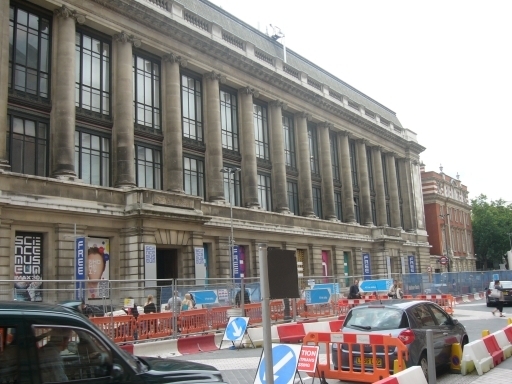
The Science Museum
I visited the British Museum, the Museum of London, the Transport Museum, Sir John Soane's Museum, the Natural History Museum, the Science Museum, the Victoria and Albert Museum, the Bank of England Museum, the Museum of Garden History, the Faraday Museum, the Imperial War Museum, the Churchill Museum, the Guards' Museum, the National Maritime Museum, the Royal Observatory Museum, the Kew Bridge Steam Museum, the National Gallery, the National Portrait Gallery, Tate Britain, Tate Modern, the Royal Academy and the Wallace Collection.
The great, state owned museums are free in London, which is a wonderful thing, encouraging huge crowds even for the regular exhibitions. The Parthenon Marbles room at British Museum was packed, and it was hard to get close to the Rosetta Stone, for instance and the Science Museum interactive displays were extremely well patronised.
Displays seemed to be of two kinds. Extremely modern and engaging, often incorporating multi-media to immerse you in the experience. 'The Trench Experience' at the Imperial War Museum, for instance, was quite harrowing. The Churchill Museum, too, brought war experience to life. It was affecting.
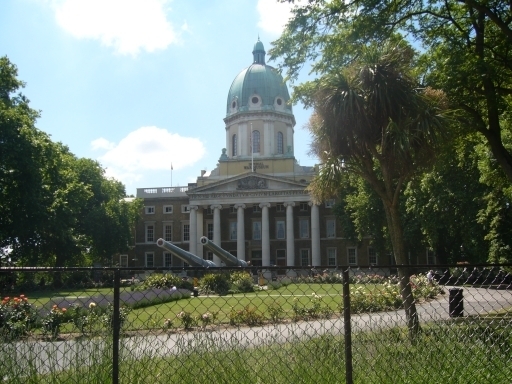
The Imperial War Museum
The other kind of display was the more traditional 'glass case and label' display. In some of the more gargantuan museums, like the Natural History Museum, or the V&A, once we moved away from the ground floor popular exhibits, we found some of these more quaint displays. They had a timeless air, and I could easily imagine Victorians and Edwardians studying these same cabinets of stuffed animals or unusual minerals, enjoying the unexpected poetry of 'Galena, Wild River, WV.'
And that was the pleasure of all the museums/galleries, huge and rambling or small and focused. They were all dedicated to knowledge. More than that, they were there to share this knowledge, for learning. They are the products of the Enlightenment and the best that that splendid time represented. Anyone can roam around these collections and partake in the intellectual enterprise in front of them. Anyone can be extended, tantalised, amused and startled.
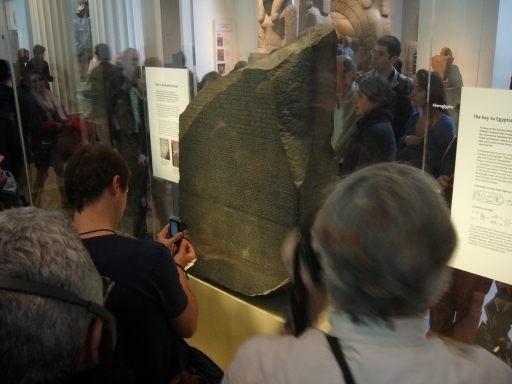
The Rosetta Stone
As Merlin said in TH White's eccentric recreation: 'The best cure for sadness is to learn something.'
I love a good museum.
July 10, 2011
Extinction Gambit Teaser
Yes, I'm going to tease you: 'She touched her lips with a finger. "I do love explosives. I just don't get the opportunity to use them as much as I'd like to."'
Title Time
I'm excited to announce the title of my new book, to be released by the wonderful people at Random House Australia in December.
It's called 'The Extinction Gambit' and it's the first book of 'The Extraordinaires'.
A helter-skelter comedy steampunk romance with extra Neanderthals.
July 2, 2011
Heroes
My recent trip to London became a pilgrimage. It wasn't planned that way, but I found paying homage to some of my long-time heroes and inspirations, deliberately seeking out their works and their memorials and acknowledging their influence.
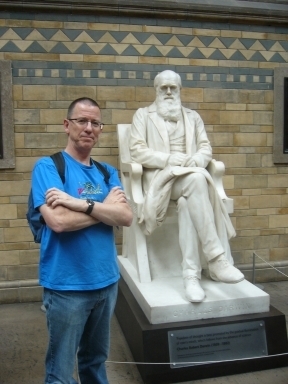
Darwin
In no particular order:
Charles Darwin. At West Minster Abbey, I sought out Darwin's burial place and memorial. The Natural History Museum was almost like a shrine dedicated to the great man, especially with the spanking brand new gob-smacking Darwin Centre. Even the Kew Gardens had a special Darwin inspired 'Evolution House'. I heard an academic once say that Darwin had 'the single best idea of anyone, ever.' Clear-thinking, rational, careful, painstaking, imaginative – Darwin has always been an inspiration.
Joseph Bazalgette. Joseph who? Bazalgette was a Victorian era engineer, and he revolutionised London. He was the one who built the staggeringly complex system of sewers that turned London from a festering cesspit into a relatively clean city. He was responsible for other works, but it's the sewers for which he'll be remembered. Can I get excited about a sewer king? You bet. This project was
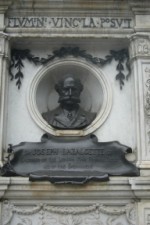 mind-numbingly difficult, uprooting the major thoroughfares of an already busy city, coordinating hundreds of workers, using millions of bricks, building huge pumping works, all to take care of something that decent people didn't really want to talk about. His memorial was hard to find – a relatively modest display on the Embankment. He deserves better. I admire his tenacity and his organisational abilities. A remarkable achiever.
mind-numbingly difficult, uprooting the major thoroughfares of an already busy city, coordinating hundreds of workers, using millions of bricks, building huge pumping works, all to take care of something that decent people didn't really want to talk about. His memorial was hard to find – a relatively modest display on the Embankment. He deserves better. I admire his tenacity and his organisational abilities. A remarkable achiever.Emmelin
 e Pankhurst. It took some effort, but I managed to find the memorial to the great champion of women's rights. Striving against an established order, organising a movement to right an entrenched wrong, remaining strong in the face of vilification and threats, Emmeline Pankhurst led women's suffrage movement in one of the most significant social revolutions of the twentieth centuries. To be so committed, so resilient, is truly inspirational
e Pankhurst. It took some effort, but I managed to find the memorial to the great champion of women's rights. Striving against an established order, organising a movement to right an entrenched wrong, remaining strong in the face of vilification and threats, Emmeline Pankhurst led women's suffrage movement in one of the most significant social revolutions of the twentieth centuries. To be so committed, so resilient, is truly inspirationalArthur Wellesley, Duke of Wellington. I found his tomb in St Paul's Cathedral, and the Wellington Monument is hard to miss – an enormous arch at Hyde Park Corner. I went to his house opposite, though, to dwell on his achievement. I'm naturally ambivalent about military leaders, but (and if) it's necessary, having a brilliant commander on your side is useful. Wellington's strategic vision was remarkable, as was his actual concern for the men on the line, the foot soldiers. He also understood about the often neglected aspect of logistics. He wasn't one of those commanders solely interested in battlefield glory. He knew the importance of supply lines and resources. The breadth of his responsibility and the courage with which he discharged it are extraordinary.
Horatio Nelson. While we're on military commanders … I'm fascinated by leadership, how it's engendered and how it can be used for good and for evil. Nelson was almost the epitome of inspiration. He led, people followed. He led through personal example, he led through sharing personal vision, he led by the simple fact that those around him had confidence in him – despite the situation. Charisma? Chutzpah? Canniness? We found his tomb in the crypt of St Paul's and it's stunning reminder of the national outpouring of grief at Nelson's death. Sometimes, in dark days we need leaders, ones who are bravery incarnate and will risk themselves to save others. Nelson did that.
Sir Christopher Wren. I found myself wandering around London to find Chris. Wren's memorials – his works. What an architect. Each church he built was different, but all of them were significant. He loved light, he loved arches and domes and spires. His buildings lift the soul. And not just churches – the palace at Hampton Court, the Monument, the Chelsea Hospital. Industrious, he was, for someone who really only took up architecture after a successful scientific career. As for his chief memorial, does anyone have a better epitaph? In the crypt of St Paul's Cathedral, on his tomb stone is written: 'If you seek his monument, look around you.'
William Shakespeare. In the past, I've been to Stratford and seen Shakespeare's tomb, but this trip to London allowed me to do something I've wanted to for a long ti
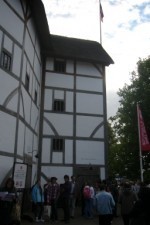 me. I went to the reconstructed Globe Theatre for a performance. After all, Shakespeare's lasting memorial is his work. We saw 'All's Well that Ends Well' and sitting in the balcony, looking down on the stage and the milling groundlings, I had a hint – a barest hint – of what it may have been like in Shakespeare's time. His creations reach out over centuries and do that for us, give us an insight into humanity in Elizabethan times, while reminding us that people are people whenever and wherever. It's a useful reminder for a writer.
me. I went to the reconstructed Globe Theatre for a performance. After all, Shakespeare's lasting memorial is his work. We saw 'All's Well that Ends Well' and sitting in the balcony, looking down on the stage and the milling groundlings, I had a hint – a barest hint – of what it may have been like in Shakespeare's time. His creations reach out over centuries and do that for us, give us an insight into humanity in Elizabethan times, while reminding us that people are people whenever and wherever. It's a useful reminder for a writer.There were others, of course. Michael Faraday. Isaac Newton. Charles Dickins. Grinling Gibbons ( a new hero!). And equally obviously, many heroes don't have monuments, either because of the times in which they lived or the sort of people they – or their friends – were.
I honour them all.



